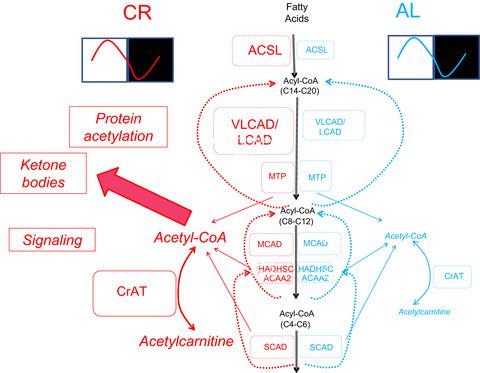当前位置:
X-MOL 学术
›
Aging Cell
›
论文详情
Our official English website, www.x-mol.net, welcomes your feedback! (Note: you will need to create a separate account there.)
CR reprograms acetyl‐CoA metabolism and induces long‐chain acyl‐CoA dehydrogenase and CrAT expression
Aging Cell ( IF 7.8 ) Pub Date : 2020-10-26 , DOI: 10.1111/acel.13266 Volha Mezhnina 1 , Ryan Pearce 2 , Allan Poe 1 , Nikkhil Velingkaar 1 , Artem Astafev 1 , Oghogho P Ebeigbe 1 , Kuldeep Makwana 1 , Yana Sandlers 2 , Roman V Kondratov 1
Aging Cell ( IF 7.8 ) Pub Date : 2020-10-26 , DOI: 10.1111/acel.13266 Volha Mezhnina 1 , Ryan Pearce 2 , Allan Poe 1 , Nikkhil Velingkaar 1 , Artem Astafev 1 , Oghogho P Ebeigbe 1 , Kuldeep Makwana 1 , Yana Sandlers 2 , Roman V Kondratov 1
Affiliation

|
Calorie restriction (CR), an age delaying diet, affects fat oxidation through poorly understood mechanisms. We investigated the effect of CR on fat metabolism gene expression and intermediate metabolites of fatty acid oxidation in the liver. We found that CR changed the liver acylcarnitine profile: acetylcarnitine, short‐chain acylcarnitines, and long‐chain 3‐hydroxy‐acylcarnitines increased, and several long‐chain acylcarnitines decreased. Acetyl‐CoA and short‐chain acyl‐CoAs were also increased in CR. CR did not affect the expression of CPT1 and upregulated the expression of long‐chain and very‐long‐chain Acyl‐CoA dehydrogenases (LCAD and VLCAD, respectively). The expression of downstream enzymes such as mitochondrial trifunctional protein and enzymes in medium‐ and short‐chain acyl‐CoAs oxidation was not affected in CR. CR shifted the balance of fatty acid oxidation enzymes and fatty acid metabolites in the liver. Acetyl‐CoA generated through beta‐oxidation can be used for ketogenesis or energy production. In agreement, blood ketone bodies increased under CR in a time of the day‐dependent manner. Carnitine acetyltransferase (CrAT) is a bidirectional enzyme that interconverts short‐chain acyl‐CoAs and their corresponding acylcarnitines. CrAT expression was induced in CR liver supporting the increased acetylcarnitine and short‐chain acylcarnitine production. Acetylcarnitine can freely travel between cellular sub‐compartments. Supporting this CR increased protein acetylation in the mitochondria, cytoplasm, and nucleus. We hypothesize that changes in acyl‐CoA and acylcarnitine levels help to control energy metabolism and contribute to metabolic flexibility under CR.
中文翻译:

CR重编程乙酰辅酶A代谢并诱导长链酰基辅酶A脱氢酶和CrAT表达
热量限制 (CR) 是一种延缓年龄的饮食,它通过知之甚少的机制影响脂肪氧化。我们研究了 CR 对脂肪代谢基因表达和肝脏中脂肪酸氧化的中间代谢产物的影响。我们发现 CR 改变了肝脏酰基肉碱谱:乙酰肉碱、短链酰基肉碱和长链 3-羟基酰基肉碱增加,几种长链酰基肉碱减少。CR 中乙酰辅酶 A 和短链酰基辅酶 A 也增加。CR 不影响 CPT1 的表达并上调长链和超长链酰基辅酶 A 脱氢酶(分别为 LCAD 和 VLCAD)的表达。下游酶如线粒体三功能蛋白和中短链酰基辅酶As氧化酶的表达在CR中不受影响。CR 改变了肝脏中脂肪酸氧化酶和脂肪酸代谢物的平衡。通过β-氧化产生的乙酰辅酶A可用于生酮或能量生产。一致地,在 CR 下血酮体以一天依赖的方式增加。肉碱乙酰转移酶 (CrAT) 是一种双向酶,可将短链酰基辅酶 A 及其相应的酰基肉碱相互转化。在 CR 肝脏中诱导 CrAT 表达,支持增加的乙酰肉碱和短链酰基肉碱的产生。乙酰肉碱可以在细胞亚室之间自由移动。支持这种 CR 增加了线粒体、细胞质和细胞核中的蛋白质乙酰化。我们假设酰基辅酶A和酰基肉碱水平的变化有助于控制能量代谢并有助于CR下的代谢灵活性。
更新日期:2020-11-23
中文翻译:

CR重编程乙酰辅酶A代谢并诱导长链酰基辅酶A脱氢酶和CrAT表达
热量限制 (CR) 是一种延缓年龄的饮食,它通过知之甚少的机制影响脂肪氧化。我们研究了 CR 对脂肪代谢基因表达和肝脏中脂肪酸氧化的中间代谢产物的影响。我们发现 CR 改变了肝脏酰基肉碱谱:乙酰肉碱、短链酰基肉碱和长链 3-羟基酰基肉碱增加,几种长链酰基肉碱减少。CR 中乙酰辅酶 A 和短链酰基辅酶 A 也增加。CR 不影响 CPT1 的表达并上调长链和超长链酰基辅酶 A 脱氢酶(分别为 LCAD 和 VLCAD)的表达。下游酶如线粒体三功能蛋白和中短链酰基辅酶As氧化酶的表达在CR中不受影响。CR 改变了肝脏中脂肪酸氧化酶和脂肪酸代谢物的平衡。通过β-氧化产生的乙酰辅酶A可用于生酮或能量生产。一致地,在 CR 下血酮体以一天依赖的方式增加。肉碱乙酰转移酶 (CrAT) 是一种双向酶,可将短链酰基辅酶 A 及其相应的酰基肉碱相互转化。在 CR 肝脏中诱导 CrAT 表达,支持增加的乙酰肉碱和短链酰基肉碱的产生。乙酰肉碱可以在细胞亚室之间自由移动。支持这种 CR 增加了线粒体、细胞质和细胞核中的蛋白质乙酰化。我们假设酰基辅酶A和酰基肉碱水平的变化有助于控制能量代谢并有助于CR下的代谢灵活性。



























 京公网安备 11010802027423号
京公网安备 11010802027423号